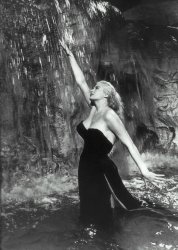Is It Really a Great Movie? Part Nineteen: La Dolce Vita
by dan heaton
Using Roger Ebert's Great Movies book as a guide, this series of articles will focus on all films included on his list that previously have escaped my notice. Since all lists are subjective, I am not treating Ebert's choices as the essential selection of films. However, his essays offer the perfect chance for me to explore both classics and lesser-known pictures from around the globe.

Legendary Italian filmmaker Federico Fellini has crafted numerous memorable pictures during his lengthy career, including 8 1/2, Nights of Cabiria, and La Strada. Many experts consider the 1960 epic La Dolce Vita to be Fellini’s greatest creation. Starring the impressive Marcello Mastroianni, the film documents the misadventures of gossip columnist Marcello Rubini as he parties with beautiful women and covers odd events. It earned numerous awards after its initial release like the Golden Palm at the Cannes Film Festival. Four Oscar nominations were also received, with Piero Gherardi’s stylish costumes taking home the prized statue. My past Fellini experience was limited to 8 1/2, and while I enjoyed its imaginative dream sequences, it also felt very overblown and self-indulgent. Would this picture arouse a similar reaction?
The film begins with a highly original sequence involving a helicopter flying a Jesus statue above the streets of Rome. While Marcello trails in another copter, he takes a quick stop to ask sunbathing ladies for their phone number. This scene quickly reveals both his primary focus (women) and the sensationalistic aspects of his job (covering odd moments). To provide further evidence of his crappy job, Marcello has a buddy named Paparazzo who inspired the now-common term paparazzi. While his associates spend their time trailing stars to grab photos, he seems unconcerned with doing much work. Instead, Marcello dances, drinks and lusts for women, which is understandable considering his job and the ladies’ tremendous beauty. However, his experience remains shallow as he drifts from one girl and party to the next.
One interesting female companion is Maddalena (Anouk Ammee) – a cool, attractive figure who appears very detached from life. Meeting Marcello in a night on the town, they journey to a prostitute’s home for a night of lovemaking. This setting is especially nasty, with flooded floors and a low-rent bedroom. Meanwhile, his official girlfriend Emma (Yvonne Furneaux) tries to kill herself by poison, which quickly removes the lighter tone and knocks the film back to reality. A similar change occurs during a sequence involving the arrival of Marcello’s father (Annibale Ninchi) for a night on the town. They visit a racy nightclub, enjoy drinks, and woo beautiful women. His father is especially fun-loving and ends up having a nightcap with an attractive young lady. However, the revelry quickly ends when his father becomes sick and shifts into a morose, possibly drunken state. The older man’s sadness conveys the realities of his age and shows the tired guy hidden beneath the carefree exterior. These conflicting moments are some of the film’s best scenes and bring much-needed emotional weight to the story.
The plot is structured as a series of vignettes loosely tied together by an ongoing story, but it lacks a standard progression. The photographers go crazy with the arrival of Sylvia (Anita Ekberg), a blond-haired Swedish actress who had been working in America. In reality, the voluptuous Ekberg was a former Miss Sweden and had been doing films in the United States. Her character immediately connects with Marcello at St. Peter’s, and romantic involvement appears imminent. However, her childlike nature reduces him to just another guy fawning over her beauty. In a classic scene, she mimics the sound of wild dogs by howling in the waters of the famed Trevi Fountain. Her appearance seems to be a key plot element, but once Sylvia disappears from the story, she never returns. Marcello’s night on the town with her injects the film with much-needed energy, especially in the silly dance scene. Ekberg is not a great actress, but everyone’s reaction to her image and flamboyance generates fun entertainment. Also, the memorable sequence exemplifies Fellini’s ability to confound audience expectations and retain a free structure.
Roger Ebert describes La Dolce Vita as a “cautionary tale of a man without a center,” which accurately summarizes Marcello’s condition. He attends lavish parties and frolics with beautiful women, but his emotional core is weak. A pivotal conversation involves his acquaintance Steiner (Alain Curry), who wows Marcello with his positive outlook on life. Unfortunately, his actual mental state might not be so hopeful. Steiner’s surprising action increases the film’s saddening tone, which severely contradicts the high style. The finale involves a big party with much cavorting and even a striptease, but the positive energy is missing. Fellini purposely drags out the story and wears down both Marcello and the audience, which lessens its effectiveness. The self-indulgence is less heightened than in 8 1/2, but the director again strays too much into less-exciting territory. La Dolce Vita includes grand scenes and unique moments fitting of a Great Movie, but its emotional resonance falls short of the best films. The film deserves a recommendation, but my personal response wasn’t strong enough to warrant this premier status.
Copyright (c) 2007 erasing clouds |
|